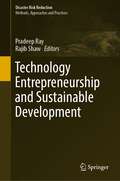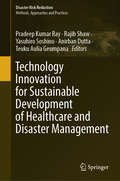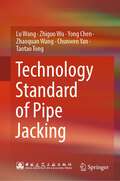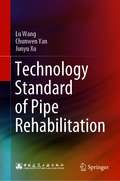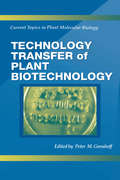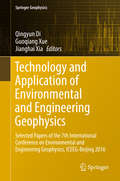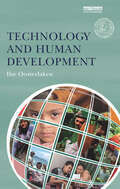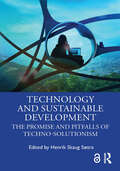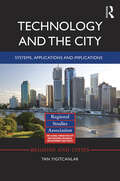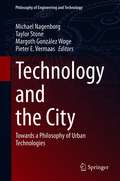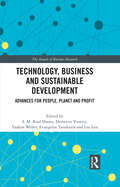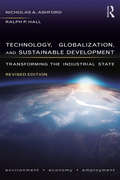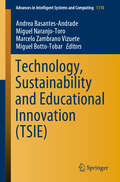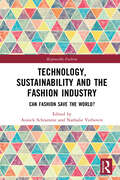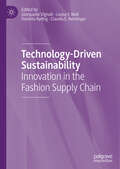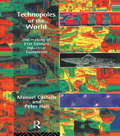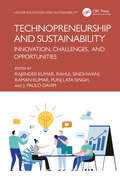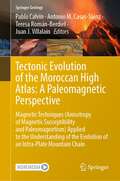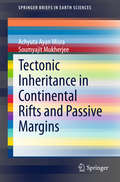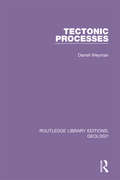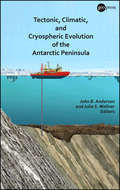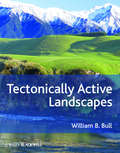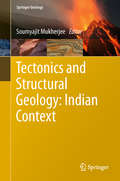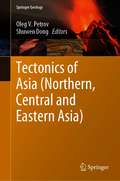- Table View
- List View
Technology Entrepreneurship and Sustainable Development (Disaster Risk Reduction)
by Rajib Shaw Pradeep RayThis book discusses the need for entrepreneurship for sustainable development from the perspective of Asia, the fastest growing region in the world. The world is now witnessing a spectacular rise of technology entrepreneurship, involving mobile phones, artificial intelligence, geospatial information systems and social media. On the other hand, governments all over the world, particularly those in low and medium income countries, are facing severe resource constraints in developing the livelihood and well-being of citizens. Although many non-government organizations (NGOs) have worked on various development projects in a number of social sectors such as health, education, disabilities, poverty alleviation and environment, there is still substantial scope for technological innovation, including more efficient, effective and user-friendly solutions in different parts of the world. This book is organized into 2 parts and consists of 17 chapters. The first part explores education and well-being, and the second part discusses the climate, environment and disaster management.
Technology Innovation for Sustainable Development of Healthcare and Disaster Management (Disaster Risk Reduction)
by Anirban Dutta Rajib Shaw Pradeep Kumar Ray Yasuhiro Soshino Teuku Aulia GeumpanaThis book provides holistic case studies of technology development, examples of its complexities and an in-depth analysis from the perspective of information infrastructure. Natural disasters such as cyclones, tsunamis, earthquakes and volcanoes have disrupted the lives of people all over the world, particularly in Asia. In order to manage disasters and mitigate the damage, many technologies—surveillance systems, for instance—have been developed. An example of natural disaster is the ongoing devastation caused by COVID-19, which highlights the multi-disciplinary nature of disaster management, including agriculture, healthcare, economics, environment, engineering and technology. The pandemic has also led to the development and uptake of technologies such as vaccine development, new biotechnological innovations, telemedicine, the Internet of things (IoT) and mobile health (mHealth) all over the world. The United Nations Sustainable Development Goals (SDGs) programme suggests an integrated approach to their development. For example, healthcare needs to be addressed in holistic perspectives including education, environment, economy and regulations, among others. These goals create challenges in the development, validation and deployment of new technology, with this book presenting a discussion of innovations in sustainable development of healthcare in the multi-disciplinary context of SDGs.
Technology Standard of Pipe Jacking
by Yong Chen Lu Wang Chunwen Yan Zhiguo Wu Zhaoquan Wang Taotao TongThis book summarizes the technical method and construction process of pipe jacking. It has a total of 17 chapters and one appendix. It includes how to prepare the pipe jacking construction, how to choose the pipe and equipment for jacking, how to choose the engineering environment, how to do the geological survey before jacking, how to design the working pit, what's the procedure of pipe jacking, how to do the measurement and monitoring during jacking, how to do the treatment and acceptance after jacking, and so on. Appendix contains reference tables for pipe jacking archives, which might aid readers in understanding the book's content. This book's language is simple to read, and it has a wealth of graphics. Even those without a foundational understanding of pipe jacking could read and comprehend it with ease. This regulation could be the fundamental discipline for pipeline jacking projects. It is the important basis and criterion for the design, construction, management, inspection, and acceptance of pipeline jacking.
Technology Standard of Pipe Rehabilitation
by Lu Wang Chunwen Yan Junyu XuThis book summarizes the technical method and construction process of underground pipeline testing, cleaning, updating and repairing. It has 20 chapters and an appendix in total. Its content includes: Pipeline rehabilitation construction organization design, Pipeline cleaning, Preparations before construction, Pipeline detection and quality assessment, Pipeline rehabilitation design/method/equipment selection/steps/technical indicators, Pipe Cracking & Bursting method, Sliplining method, Pipe Segments Method, Lining with Inserted hose(improved) method, Cured in place pipe(CIPP), Spray lining, Spiral winding method, Spot repair method, universal construction techniques, construction of general rules, the engineering quality acceptance, construction health, safety, environmental protection and production management, and so on. The appendix is the interpretation for the relevant technical terms in this book. It could help the reader who doesn’t have the basic knowledge about pipe rehabilitation to understand this technology easily. This regulation could be the fundamental discipline for pipeline renewal projects in different industries. It could provide the important basis and criterion for design, construction, management, inspection and acceptance of pipeline renewal projects.
Technology Transfer of Plant Biotechnology (Current Topics In Plant Molecular Biology Ser. #3)
by Peter M. GresshoffPlant biotechnology has come of age. Products obtained by genetically engineered methods, once limited to science fiction, have become a reality. This book is an outstanding synthesis of the current status of technology transfer from the laboratory to the marketplace. It discusses the use of genetically engineered crops, with the focus on biotechnology becoming commercially marketable. Technology Transfer of Plant Biotechnology addresses these important new products.
Technology and Application of Environmental and Engineering Geophysics
by Guoqiang Xue Qingyun Di Jianghai XiaThis book focuses on essential theories, methods and techniques in the field of environmental and engineering geophysics that can contribute to resource detection and environmental protection. Geophysics has been playing an important role in exploring our own planet, locating vital resources and promoting the development of society. The book covers a range of topics including the exploration of modern resources, such as oil and gas, ore deposits, coal mines, shale gas and geothermal power, and the monitoring of geological disasters, including the rock-soil body, ground deformation, mines, specific rock-soil engineering disasters, desertification of land and environmental abnormalities. This book not only offers a valuable resource for geophysical researchers; it also demonstrates how geophysics theories and methods can be practically implemented to protect our environment and promote the development of human society.
Technology and Human Development (The Routledge Human Development and Capability Debates)
by Ilse OosterlakenThis book introduces the capability approach – in which wellbeing, agency and justice are the core values – as a powerful normative lens to examine technology and its role in development. This approach attaches central moral importance to individual human capabilities, understood as effective opportunities people have to lead the kind of lives they have reason to value. The book examines the strengths, limitations and versatility of the capability approach when applied to technology, and shows the need to supplement it with other approaches in order to deal with the challenges that technology raises. The first chapter places the capability approach within the context of broader debates about technology and human development – discussing amongst others the appropriate technology movement. The middle part then draws on philosophy and ethics of technology in order to deepen our understanding of the relation between technical artefacts and human capabilities, arguing that we must simultaneously ‘zoom in’ on the details of technological design and ‘zoom out’ to see the broader socio-technical embedding of a technology. The book examines whether technology is merely a neutral instrument that expands what people can do and be in life, or whether technology transfers may also impose certain views of what it means to lead a good life. The final chapter examines the capability approach in relation to contemporary debates about ‘ICT for Development’ (ICT4D), as the technology domain where the approach has been most extensively applied so far. This book is an invaluable read for students in Development Studies and STS, as well as policy makers, practitioners and engineers looking for an accessible overview of technology and development from the perspective of the capability approach.
Technology and Sustainable Development: The Promise and Pitfalls of Techno-Solutionism
by Henrik Skaug SætraTechnological change is at the core of all major disruptions in human history, and revolutions, wars, and general development are regularly connected to some sort of technological change. However, not all development is beneficial. While technology has fueled great innovations and rapid development, the notion of sustainable development has gained prominence as we now experience serious social, economic, and environmental challenges. This book examines whether technology can be used to fix the very problems caused by technology, as the various chapters examine different aspects related to how technology has brought us where we are today (which some will say is the best place humanity’s been at according to a range of metrics), and whether technology helps or hinders us in our efforts to solve the challenges we currently face. The issues discussed cover the three sustainability dimensions and include topics such as the materiality of AI, technology in education, AI for gender equality, innovation and the digital divide, and how technology relates to power, the political system, and capitalism. The chapters all build on the theoretical backdrop of technological change, sustainable development, and the UN’s Sustainable Development Goals are actively used throughout this book, both to examine how these goals capture or overlook central elements of sustainable development, and also to facilitate and create a common framework of engagement between the chapters. This book provides a novel combination of traditional theories that are explored through different case studies, providing the ground for a better understanding of how and when technology can –and cannot –be the enabler of sustainable development. It is thus an important resource for students of all disciplines, technologists, and those developing and applying new technologies. It is also a valuable resource for politicians and regulators attempting to harness the power of technology for good, while limiting its negative potential. The Open Access version of this book, available at www.taylorfrancis.com, has been made available under a Creative Commons [Attribution-Non Commercial-No Derivatives (CC-BY-NC-ND)] 4.0 license. Funded by Ostfold University College.
Technology and the City: Systems, applications and implications (Regions and Cities)
by Tan YigitcanlarThe interplay between smart urban technologies and city development is a relatively uncharted territory. Technology and the City aims to fill that gap, exploring the growing importance of smart technologies and systems in contemporary cities, and providing an in-depth understanding of both theoretical and practical aspects of smart urban technology adoption, and its implications for our cities. Beginning with an elaboration of the historical significance of technologies in economic growth, social progress and urban development, Yigitcanlar introduces the most prominent smart urban information technologies. The book showcases significant smart city practices from across the globe that uses smart urban technologies and systems most effectively. It explores the role of these technologies and asks how they can be adopted into the planning, development and management processes of cities for sustainable urban futures. This pioneering volume contributes to the conceptualisation and practice of smart technology and system adoption in our cities by disseminating both conceptual and empirical research findings with real-world best practice applications. With a multidisciplinary approach to themes of technology and urban development, this book is a key reference source for scholars, practitioners, consultants, city officials, policymakers and urban technology enthusiasts.
Technology and the City: Towards a Philosophy of Urban Technologies (Philosophy of Engineering and Technology #36)
by Pieter E. Vermaas Michael Nagenborg Taylor Stone Margoth González WogeThe contributions in this volume map out how technologies are used and designed to plan, maintain, govern, demolish, and destroy the city. The chapters demonstrate how urban technologies shape, and are shaped, by fundamental concepts and principles such as citizenship, publicness, democracy, and nature. The many authors herein explore how to think of technologically mediated urban space as part of the human condition. The volume will thus contribute to the much-needed discussion on technology-enabled urban futures from the perspective of the philosophy of technology. This perspective also contributes to the discussion and process of making cities ‘smart’ and just. This collection appeals to students, researchers, and professionals within the fields of philosophy of technology, urban planning, and engineering.
Technology, Business and Sustainable Development: Advances for People, Planet and Profit (The Annals of Business Research)
by Demetris Vrontis Yaakov Weber Evangelos Tsoukatos Lea Iaia Shams, S. M. RiadTriple bottom line (TBL or 3BL) was coined as a wide and inspiring approach for businesses aimed at understanding how to create, track, and manage economic, social, and environmental values added. The sustainability sector is strongly increasing its relevance among academics and practitioners, and the market opportunities associated with the sustainable development goals (SDGs) are estimated at over $ 12 trillion per year by 2030. Although this is a promising context, a recent article suggested a rethinking of the TBL, arguing that sustainability goals’ value should not be assessed in terms of profit and loss but of people well-being and planet health, looking for a societal profit. Technology plays a crucial role in our society. Respectively, the Agenda 21 and the Paris Agreement consider technology to be essential in the pursuit of sustainable development and the achievement of the SDGs. Adding to this, the Covid-19 pandemic has accelerated the adoption of digital solutions in several fields, from the way of working to the way of buying and consuming. Companies are becoming more aware of the responsibility they have within environmental and human contexts, and people are looking for work reflecting their values and purposes to motivate them. This book aims to contribute to the understanding of the role of technology and its emerging and innovative solutions in the achievement of sustainable development while making a profit. It will be of value to researchers, academics, practitioners, and students in the fields of strategic management, entrepreneurship, management of technology and innovation, and sustainable development.
Technology, Globalization, and Sustainable Development: Transforming The Industrial State
by Nicholas A Ashford Ralph P HallTechnology, Globalization, and Sustainable Development offers a unified, transdisciplinary approach for transforming the industrial state in order to promote sustainable development. The authors present a deep analysis of the ways that industrial states – both developed and developing – are currently unsustainable and how economic and social welfare are related to the environment, to public health and safety, and to earning capacity and meaningful and rewarding employment. The authors offer multipurpose solutions to the sustainability challenge that integrate industrial development, employment, technology, environment, national and international law, trade, finance, and public and worker health and safety. The authors present a compelling wake-up call that warns of the collision course set between the current paths of continued growth and inevitable unsustainability in the world today. Offering clear examples and real solutions, this textbook illustrates how the driving forces that are currently promoting unsustainability can be refocused and redesigned to reverse course and improve the state of the world. This book is essential reading for those teaching and studying sustainable development and the critical roles of the economy, employment, and the environment.
Technology, Sustainability and Educational Innovation (Advances in Intelligent Systems and Computing #1110)
by Miguel Botto-Tobar Andrea Basantes-Andrade Miguel Naranjo-Toro Marcelo Zambrano VizueteThis book presents the proceedings of International Conference on Knowledge Society: Technology, Sustainability and Educational Innovation (TSIE 2019). The conference, which was held at UTN in Ibarra, Ecuador, on 3–5 July 2019, allowed participants and speakers to share their research and findings on emerging and innovative global issues. The conference was organized in collaboration with a number of research groups: Group for the Scientific Research Network (e-CIER); Research Group in Educational Innovation and Technology, University of Salamanca, Spain(GITE-USAL); International Research Group for Heritage and Sustainability (GIIPS), and the Social Science Research Group (GICS). In addition, it had the endorsement of the RedCLARA, e-science, Fidal Foundation, Red CEDIA, IEEE, Microsoft, Business IT, Adobe, and Argo Systems. The term “knowledge society” can be understood as the management, understanding and co-creation of knowledge oriented toward the sustainable development and positive transformation of society. In this context and on the occasion of the XXXIII anniversary of the Universidad Técnica del Norte (UTN), the Postgraduate Institute through its Master of Technology and Educational Innovation held the I International Congress on Knowledge Society: Technology, Sustainability and Educational Innovation – TSIE 2019, which brought together educators, researchers, academics, students, managers, and professionals, from both the public and private sectors to share knowledge and technological developments. The book covers the following topics: 1. curriculum, technology and educational innovation; 2. media and education; 3. applied computing; 4. educational robotics. 5. technology, culture, heritage, and tourism development perspectives; and 6. biodiversity and sustainability.
Technology, Sustainability and the Fashion Industry: Can Fashion Save the World? (Responsible Fashion)
by Annick Schramme Nathalie VerbovenThere is widespread rhetorical agreement that the fashion industry must get itself onto a more sustainable footing. What does this mean in practice, and how can sustainability be achieved in different regions around the world? This book brings together expert scholars and reflective practitioners via a network of dialogue and exchange to help drive forward a sustainable future for the fashion industry. With a focus on technological innovation, the contributions to this book provide a range of case studies from design thinking, through digital clothing and inclusive fashion. This book will be of interest to researchers and scholars in the fields of circular business and the fashion industry, and provides a unique resource for readers seeking to understand more about the need for responsible fashion and how technology might be able to help.
Technology-Driven Sustainability: Innovation in the Fashion Supply Chain
by Claudia E. Henninger Daniella Ryding Gianpaolo Vignali Louise F. ReidThis book provides a critical overview of technologies that are used within the fashion industry and supply chain, with a special emphasis on how they engender sustainability and the circular economy. The chapters present contemporary case studies alongside new research on technologies such as 3D printing, 3D scanning and recycling technology to assess the effect they will have on the future of fashion and its global supply chain.
Technopoles of the World: The Making of 21st Century Industrial Complexes
by Manuel CastellsTechnopoles - planned centres for the promotion for high- technology industry - have become a key feature of national economic development worldwide. Created out of a technological revolution, the formation of the global economy and the emergence of a new form of economic production and management, they constitute the mines and foundries of the information age, redefining the conditions and processes of local and regional development. This book is the first systematic survey of technopoles in all manifestations: science parks, science cities, national technopoles and technobelt programmes. Detailed case studies, ranging from the Silicon Valley to Siberia and from the M4 Corridor to Taiwan, relate how global technopoles have developed, what each is striving to achieve and how well it is succeeding. Technopoles of the World distills the lessons learnt from the successes and failures, embracing a host of disparate concepts and a few myths, and offering guidelines for national, regional and local planners and developers worldwide.
Technopreneurship and Sustainability: Innovation, Challenges, and Opportunities (Higher Education and Sustainability)
by J. Paulo Davim Raman Kumar Rahul Sindhwani Punj Lata Singh Rajender KumarTechnopreneurship is an advanced version of entrepreneurship that incorporates cutting-edge technologies from AI to big data into entrepreneurial activities and leads to innovative solutions to problems that previous solutions have failed to sustain in the long term. This book explains the fundamentals of developing and establishing a small one-person business or a large organization, building technological solutions, and performing effectively and efficiently. It covers all aspects of an entrepreneurial journey, guiding readers from the startup stage, growing a business, sustainability, and clarifies the role of technopreneurship as a tool to enhance sustainability in today’s entrepreneurial ventures.Features Explains the theory and the practice of entrepreneurship in today’s technological era Presents technological developments, their implementations, and the potential outcomes of technology used in entrepreneurial activities Covers sustainability and the role of technologies to achieve sustainable development goals associated with different ventures Discusses ways to minimize failures of entrepreneurial ventures especially in startups Includes real-life case studies focused on today’s problems and solutions This book is ideal for undergraduate and graduate students taking courses in Entrepreneurship and Startup as well as business consultants and business owners in any field.
Tectonic Evolution of the Moroccan High Atlas: Magnetic Techniques (Anisotropy of Magnetic Susceptibility and Paleomagnetism) Applied to the Understanding of the Evolution of an Intra-Plate Mountain Chain (Springer Geology)
by Pablo Calvín Antonio M. Casas-Sainz Teresa Román-Berdiel Juan J. VillalaínThis book presents a significant amount of structural, paleomagnetic and magnetic fabric data in the Central High Atlas (Morocco). The authors thoroughly described and analyzed the present-day structure of this intraplate chain through 22 of cross-sections, potential field data analysis and 3D reconstruction. In addition, the authors propose a palinspastic reconstruction of the structure of the basin at 100 Ma (i.e., post-extension and pre-compression) to finally evaluate its Mesozoic and Cenozoic geodynamic evolution. This books presents (1) a unique three-dimensional model at the chain scale, (2) an analysis of the ca. 100 Ma remagnetization, to perform palinspastic restorations of most representative structures, (3) as well as the interpretation of the magnetic fabrics in order to unravel the tectonic or deformation setting that the rocks underwent in different parts of the basin. This book is of interest to structural geologists in Northern Africa, the Mediterranean and Iberia, as well as to those interested in inverted intraplate basins and paleomagnetists from around the planet. Also, this book is intended to help students to understand better the geological evolution of the Atlas and therefore Morocco and surrounding areas.
Tectonic Geomorphology
by Robert S. Anderson Douglas W. BurbankTectonic geomorphology is the study of the interplay between tectonic and surface processes that shape the landscape in regions of active deformation and at time scales ranging from days to millions of years. Over the past decade, recent advances in the quantification of both rates and the physical basis of tectonic and surface processes have underpinned an explosion of new research in the field of tectonic geomorphology. Modern tectonic geomorphology is an exceptionally integrative field that utilizes techniques and data derived from studies of geomorphology, seismology, geochronology, structure, geodesy, stratigraphy, meteorology and Quaternary science. While integrating new insights and highlighting controversies from the ten years of research since the 1st edition, this 2nd edition of Tectonic Geomorphology reviews the fundamentals of the subject, including the nature of faulting and folding, the creation and use of geomorphic markers for tracing deformation, chronological techniques that are used to date events and quantify rates, geodetic techniques for defining recent deformation, and paleoseismologic approaches to calibrate past deformation. Overall, this book focuses on the current understanding of the dynamic interplay between surface processes and active tectonics. As it ranges from the timescales of individual earthquakes to the growth and decay of mountain belts, this book provides a timely synthesis of modern research for upper-level undergraduate and graduate earth science students and for practicing geologists.Additional resources for this book can be found at: www.wiley.com/go/burbank/geomorphology.
Tectonic Inheritance in Continental Rifts and Passive Margins
by Soumyajit Mukherjee Achyuta Ayan MisraThis work reviews the mechanism of rifting with a focus on pre-existing tectonic weaknesses in pre-rift and/or basement rocks, i. e. , on tectonic inheritance. The passive margins that are studied in this book are the Norwegian Continental Shelf, the Eastern North America and the East and West Indian Continental Margins. The continental rifts that have been analysed are the East African Rift System, the Brazilian Continental Rift Systems and the European Cenozoic Rift System. It states how rifts and passive margins serve as valuable locations for hydrocarbon exploration. Tectonic inheritance/heritage examines the influence of pre-existing/pre-rift elements on the geometry, genesis and propagation of rift-related faults. Such elements include anisotropies in the shallow crustal levels, as well as the rheology of the lithosphere. Inheritance greatly influences the architecture of rifted passive margins including the attitude of faults and geometry of horsts, (half-) grabens, transfer zones etc. Inheritance is also a determining factor in the width of rifts and rift shoulder topography.
Tectonic Processes (Routledge Library Editions: Geology #28)
by Darrell WeymanThis book, first published in 1981, provides an excellent introductory analysis to plate tectonic theory. It covers plate tectonics, continental drift, mountain building, ocean trenches, earthquakes and volcanoes.
Tectonic, Climatic, and Cryospheric Evolution of the Antarctic Peninsula (Special Publications #63)
by John B. Anderson Julia S. WellnerPublished by the American Geophysical Union as part of the Special Publications Series. Tectonic, Climatic, and Cryospheric Evolution of the Antarctic Peninsula presents the analysis of data collected during the SHALDRIL program, which sampled the most complete Cenozoic stratigraphic section in the Antarctic Peninsula. The stratigraphic intervals sampled fill major gaps in the existing stratigraphic record in the region, which is believed to have been the last place in Antarctica to become fully glaciated and, as such, the last refugium for plants and animals living on the continent. Providing previously unpublished results from studies aimed at improving our understanding of the changes in climate, glacial setting, and fauna and flora that took place over the past 30 million years, the volume highlights include discussions of marine seismic and drill core records documenting the initial growth and expansion of an ice sheet across the northernmost Antarctic Peninsula continental shelf in the northwestern Weddell Sea. The book features: Detailed vegetation and phytoplankton evolution from greenhouse through icehouse conditions in Antarctica's last refugium Sand grain texture and micromorphology indicating ice sheet control of weathering style Exhumational history around the Drake Passage margins from thermochronology and sediment provenance Comprehensive review of the opening of the ocean passageway between Antarctica and South America and the associated regional tectonics. Tectonic, Climatic, and Cryospheric Evolution of the Antarctic Peninsula will be of interest to geologists, climatologists, and glaciologists interested in climate and cryosphere evolution and those factors that regulate it.
Tectonically Active Landscapes
by William B. BullThis book explores how mountainous landscapes respond to tectonic deformation. It integrates previously unpublished concepts and ideas with recent articles about hills and streams. Readers will learn which landforms change quickly in response to uplift, which parts of the landscape are slowest to adjust to tectonic perturbations, and which landform characteristics are most useful for describing tectonically active and inactive terrains. Study areas include diverse landscapes and tectonic settings: seacoasts, soil-mantled hills, and lofty mountains. The humid Southern Alps of New Zealand change quickly because of rapid uplift and erosion. The semiarid Panamint Range of southeastern California has such miniscule annual stream power that tectonic landforms persist for millions of years.Tectonically Active Landscapes addresses diverse key topics about tectonics and topography. It is essential reading for research geologists and advance-level undergraduate and graduate students in the earth sciences.
Tectonics and Structural Geology: Indian Context (Springer Geology)
by Soumyajit MukherjeeThis book presents a compilation of findings, review and original works, on the tectonic evolution and structural detail of several terrains in India. It captures the tectonic diversity of the Indian terrain, including tectonics of India's coastal areas, the tectonic evolution of Gondwana and Proterozoic (Purana) basins. It also describes the research results of the Indian craton's geo-history, Tertiary Bengal basin, and also the Himalayan collisional zone. Thus the book covers the deformation history of Indian terrain involving strike slip, compressional and extensional tectonics, and ductile and brittle shear deformations.
Tectonics of Asia (Springer Geology)
by Oleg V. Petrov Shuwen DongThe book provides the results of tectonic, geological and geophysical studies of Northern, Central and Eastern Asia obtained over the last 20 years, and a Tectonic map for this area overview as well as essays on its geodynamic evolution. These new results were obtained by an international team of specialists within the project “Atlas of geological maps of Central Asia and adjacent areas,” scale 1: 2,500,000, initiated in 2003 by geological surveys of Russia, China, Mongolia, Kazakhstan and South Korea under the auspices of the CGMW. The most of the book contains the descriptions of the tectonic structure of major geological regions of Asia, such as the Ural, Sayan-Baikal and Tien Shan orogenic systems. The tectonic structure of the Pamirs, Turan Plate, Mongolia, Southern China, Korea and other regions is also discussed. The book contains maps of gravity and magnetic anomalies, sketch maps of deep structures of the area, and the geotransect crossing the most important geological structures of Asia. The final chapter of the book describes the tectonic evolution of the Central Asian Orogenic Belt from the Neoproterozoic to the Mesozoic.
